中考英语二轮语法专项复习课件 第13讲 非谓语动词
文档属性
| 名称 | 中考英语二轮语法专项复习课件 第13讲 非谓语动词 |  | |
| 格式 | pptx | ||
| 文件大小 | 1.1MB | ||
| 资源类型 | 试卷 | ||
| 版本资源 | 鲁教版 | ||
| 科目 | 英语 | ||
| 更新时间 | 2023-12-28 15:37:30 | ||
图片预览




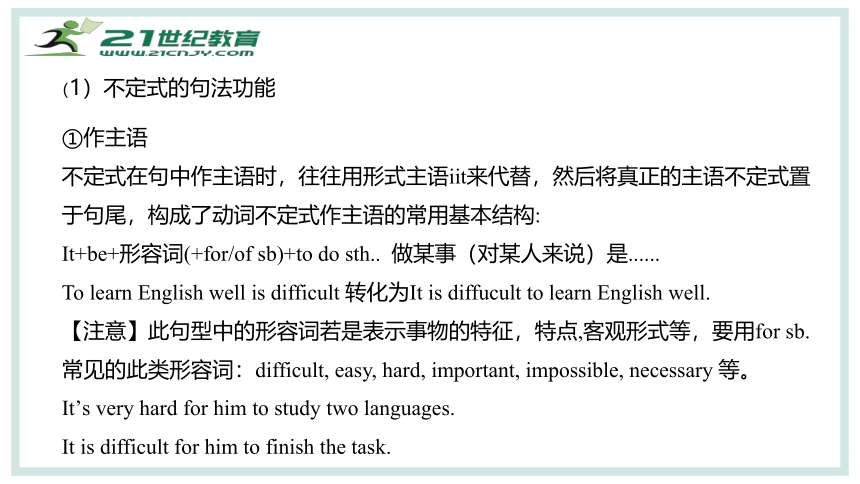

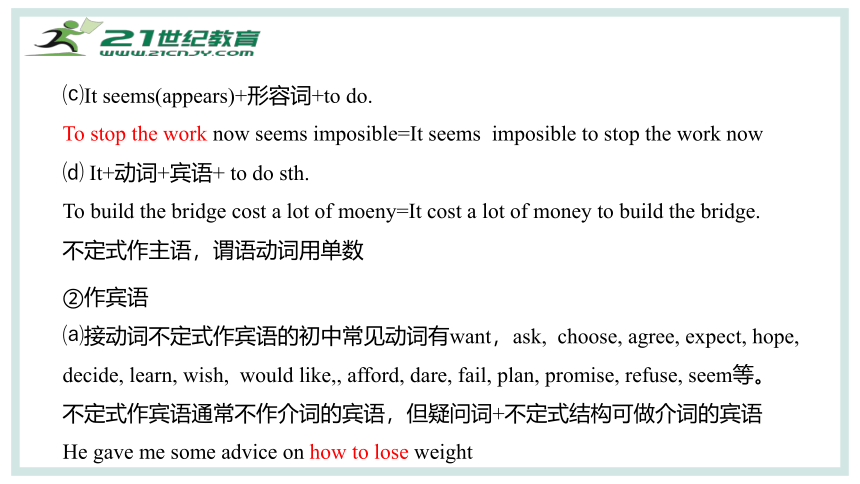
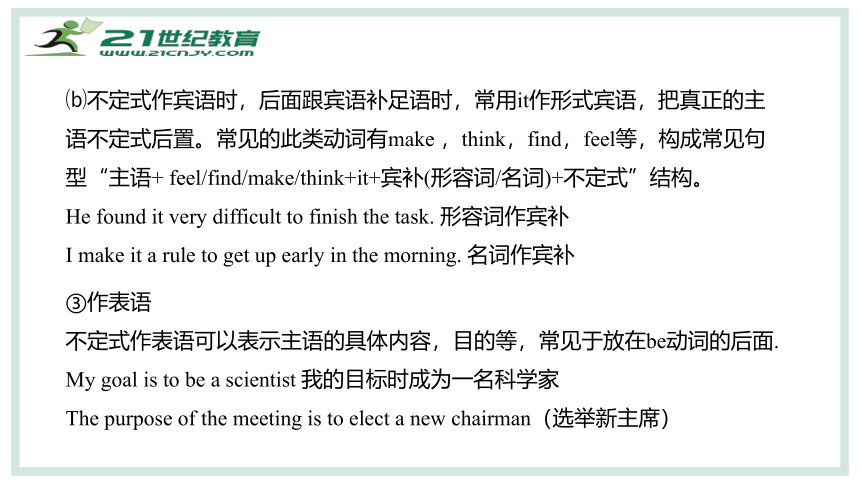
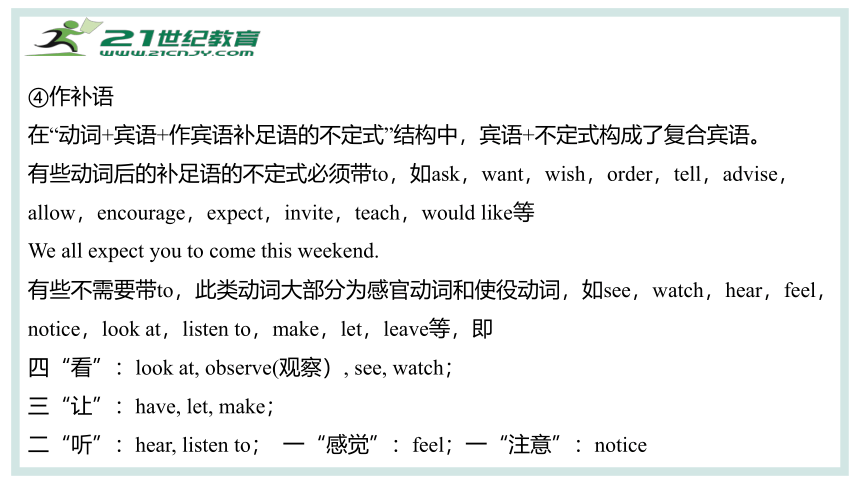


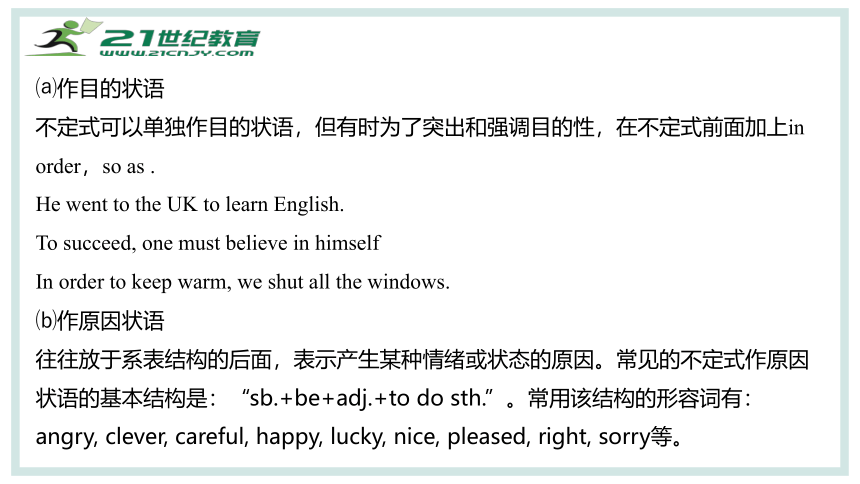
文档简介
(共39张PPT)
第十三讲 非谓语动词
中考英语专项复习
1.掌握非谓语动词的分类及构成;
2.掌握非谓语动词的使用。
学习目标
非谓语动词指不能单独作谓语,没有人称和数的变化,但仍保留动词
某些特征的动词形式。
非谓语动词包括不定式,动名词,分词( 现在分词,过去分词)。
一 动 词 不 定 式
动词不定式的基本形式:to+动词原形
这里的to为不定式符号,本身无实际词义,注意有的动词可以不用to。
不定式的否定形式是在前面加上not构成,
如 He asked me not to tell the news to his wife.
动词不定式相当于名词,形容词,副词,因此动词不定式可作主语、表语、宾语、定语、状语和宾语补足语。
(1)不定式的句法功能
①作主语
不定式在句中作主语时,往往用形式主语iit来代替,然后将真正的主语不定式置于句尾,构成了动词不定式作主语的常用基本结构:
It+be+形容词(+for/of sb)+to do sth.. 做某事(对某人来说)是......
To learn English well is difficult 转化为It is diffucult to learn English well.
【注意】此句型中的形容词若是表示事物的特征,特点,客观形式等,要用for sb.常见的此类形容词:difficult, easy, hard, important, impossible, necessary 等。
It’s very hard for him to study two languages.
It is difficult for him to finish the task.
此句型中的形容词若是表示人物的性格、品德、主观感情、态度、赞扬或批评等,要用of sb. 常见的此类形容词有clever, good, foolish, honest, kind, lazy, nice,, silly, stupid, wise, brave,right 等。
It’s very nice of you to help me.
不定式作主语,其它常用句型:
It+be+名词+to do sth.
To live in China is Mr White’s dream= It is Mr White’s dream to live in China
It takes/took/will take sb+some time+to do sth. To finish my homework took me two hours.=It took me two hours to finish my homework
.
It seems(appears)+形容词+to do.
To stop the work now seems imposible=It seems imposible to stop the work now
It+动词+宾语+ to do sth.
To build the bridge cost a lot of moeny=It cost a lot of money to build the bridge.
不定式作主语,谓语动词用单数
②作宾语
接动词不定式作宾语的初中常见动词有want,ask, choose, agree, expect, hope, decide, learn, wish, would like,, afford, dare, fail, plan, promise, refuse, seem等。
不定式作宾语通常不作介词的宾语,但疑问词+不定式结构可做介词的宾语
He gave me some advice on how to lose weight
不定式作宾语时,后面跟宾语补足语时,常用it作形式宾语,把真正的主语不定式后置。常见的此类动词有make ,think,find,feel等,构成常见句型“主语+ feel/find/make/think+it+宾补(形容词/名词)+不定式”结构。
He found it very difficult to finish the task. 形容词作宾补
I make it a rule to get up early in the morning. 名词作宾补
③作表语
不定式作表语可以表示主语的具体内容,目的等,常见于放在be动词的后面.
My goal is to be a scientist 我的目标时成为一名科学家
The purpose of the meeting is to elect a new chairman(选举新主席)
④作补语
在“动词+宾语+作宾语补足语的不定式”结构中,宾语+不定式构成了复合宾语。
有些动词后的补足语的不定式必须带to,如ask,want,wish,order,tell,advise,allow,encourage,expect,invite,teach,would like等
We all expect you to come this weekend.
有些不需要带to,此类动词大部分为感官动词和使役动词,如see,watch,hear,feel,notice,look at,listen to,make,let,leave等,即
四“看”:look at, observe(观察), see, watch;
三“让”:have, let, make;
二“听”:hear, listen to; 一“感觉”:feel;一“注意”:notice
文本信息
Did you see anyone enter the house?
有的带to或不带to都可以 如help
Can you help me (to) learn English?
⑤作定语
不定式作定语可以用来修饰人或物,一般放于被修饰词的后面。一般当中心词为序数词,最高级,the last,the only等或中心词被这类词修饰时,多用不定式。
He was the first guest to arrive.
I am the only one to hear the news.
Please give me some books to read.
I have nothing to say .
作定语的不定式如果是不及物动词,或者不定式所修饰的名词或代词是不定式动作的地点、工具等,不定式后需要有相应的介词。但当名词是time, place或way时,不定式后的介词可以省略。
Could you lend me a pen to write with?
He has a comfortable house to live in.
I had no food and no place to live (in).
⑥作状语
不定式作状语主要表示原因,目的,结果等
作目的状语
不定式可以单独作目的状语,但有时为了突出和强调目的性,在不定式前面加上in order,so as .
He went to the UK to learn English.
To succeed, one must believe in himself
In order to keep warm, we shut all the windows.
作原因状语
往往放于系表结构的后面,表示产生某种情绪或状态的原因。常见的不定式作原因状语的基本结构是:“sb.+be+adj.+to do sth.”。常用该结构的形容词有:angry, clever, careful, happy, lucky, nice, pleased, right, sorry等。
I am sorry to hear you are ill. I am glad to see you again
作结果状语,常用于too...to...,enough...to...,so./such...as to...结构中,有时可指出人意料的结果,这时不定式前常加only来加强语气。
The shirt is too small for me to wear.
The child is old enough to dress himself.
We hurried to the station only to be told that the train has left.
作评论性的状语
有些不定式用来表明说话者的观点或态度的,放于句子之外,修饰整个句子。
To be honest,I just don’t like his works(作品).
He is a nice person, to be sure .毫无疑问,他是个好人。
(2)不定式的特殊结构
①疑问词+不定式结构
疑问词包括疑问代词如who,whom,what,which,whose
疑问副词如when,where,how等
在句子中作主语,宾语,表语,宾补等,此外whether后面也可接不定式。 此结构作主语时,谓语动词用单数。
此类不定式结构常用在decide, know, consider, forget, learn, remember, show, understand, see, wonder, hear, find out, explain, tell等动词后面作宾语或宾补。
How to solve the problem has not decided yet.(作主语)
I am still wondering when to start off(出发)(作宾语)
The question is how to put it into practice. (作表语)
Can you tell me how to get to the post office (作宾补)
有些动词如show,know只能用此类结构的不定式,不能直接加不定式
I don’t know what to do next.
Could you please show me how to use the computer?
②动词不定式的省略:
感官动词(see,hear等)和使役动词(make,let,have)后面,不再赘述.
在You’d(not)+动词原形”你最好(不)做某事
Why not+动词原形? Why don’t you+动词原形
输入标题文本信息
标题数字等都可以通过点击和重新输入进行更改。文字数字大小颜色参考此模板
would rather+动词原形”宁愿作某事 cannot but do sth 只好作某事
do nothing but do sth 只好作某事 have nothing to do but do sth 只能作某事
“Will/Would /Could you please(not)+动词原形 ”句型中,
动词不定式符号to常常省略
此外help后的to有时也可省略
省略与上文相同的动词,保留不定式符号to
为了避免重复,有时不定式中可以省略与上文相同的主要动词,只保留不定式符号to。常用的此类动词在动词except, hope, wish, forget, want, try等,动词短语be glad/happy, wouldlove,would like,have to, be able to, be going to, used to,ought to等
---Would you like to come with us?
---Yes,I’d love to
You can go with us if you want to
如果不定式的主要动词含有be或助动词have,那么be和have 不能省略
---Is your father a reporter?
---No,but he used to be.
---Have you told Amy about the lecture?
---Sorry,but I ought to have.
二 动 名 词
动名词的基本形式:动词原形+ing
动名词与现在分词同形。
动名词既有动词的特征,也有名词的特征,在句中可做主语,表语,宾语和定语
点击此处
输入文本信息
(1)动名词的句法功能
①作主语
动名词作主语往往表示一种概念,习惯或经验。动名词作主语时,谓语要用动词用第三人称单数形式。
Finding a job is difficult these days.
Growing flowers is my hobby.
动名词作主语时有时用it作形式主语,把真正的主语动名词置于句尾。这种用法常见与 It’s use/good/fun....,或It‘s useful /nice/useles...等句式中.
It is fun playing with children.
It is nice seeing you again.
点击此处
输入文本信息
②作表语
动名词作表语多说明主语的内容,表示笼统的,抽象的概念.
My hobby is painting.
Seeing is believing.
多数情况下动名词作表语时,表语可以转换成作主语。
如Painting is my hobby.
③作宾语
动名词作宾语,往往表示表示一般的习惯、抽象的行为或经常性的动作。动名词既可以作动词的宾语,也可作介词的宾语。
作动词的宾语
初中阶段常见的接动名词作宾语的动词或词组有:advise,allow,avoid,enjoy, finish, consider, miss, keep, mind, practise, risk, suggest, imagine,stand include,can't help 禁不住等
作介词的宾语
初中阶段常见的接动名词作宾语的有介词的短语:动词(+名词/副词)+介词结构,
名词+介词结构,形容词+介词结构。常见的短语有:feel like, give up,keep on,put off, look forward to,be/get/become used to 习惯于 stick to 坚持 lead to导致
pay atention to 注意 have trouble/difficulty/a problem/problems/fun(in)doing sth
其它的如放于形容词后be worth doing be busy doing 也要注意
点击此处
输入文本信息
④作定语
动名词作定语修饰名词,置于所修饰词之前,说明被修饰词的用途,所属关系。在意义上相当于:名词+for+doing。
a swimming pool = a pool for swimming
a reading room = a room for reading
a dining hall
(2)动名词使用的其它注意事项
①部分动词如hate, like, love等接不定式作宾语时,通常表示一次性或具体性的动作;接动词-ing 形式做宾语时,通常表示一般性或习惯性的动作。
I hate to go fishing today. 今天我不想去钓鱼。I hate going fishing. 我讨厌钓鱼。
② 部分动词如 begin, continue, start,prefer等接不定式或动词名词做宾语时意义区别不大。
We began learning/to learn history when we came to junior middle school(初中)
③ 部分动词后面既可接不定式作宾语,也可跟动名词作宾语,意思不同。
如forget, remember, regret等,后接不定式作宾语,表示动作未发生;后接动名词作宾语,表动作已发生。
remember to do sth. 记住去做某事(未做) remember doing sth. 记得曾经做过某事(已做);
forget to do sth. 忘记去做某事(未做) forget doing sth. 忘记曾经已经做过某事(已做);
regret to do sth. 对要做的事表示遗憾、后悔(未做);
regret doing sth. 对做过的事表示遗憾、后悔 (已做)。
I remember seeing you somewhere before. 我记得以前在哪儿见过你。
Please remember to turn off the light when you leave the classroom. 离开教室时请记得关好灯
④ try接不定式作宾语时,意思是“设法去做,尽力去做”,侧重于为达到目的而努力;接动名词形式做宾语时,意思是“尝试着去做”,侧重于尝试。
try to do sth. 尽力/努力/企图做某事;
try doing sth. 试验/试着做某事
I'm trying to learn English well。我决心(尽力)学好英语。
I tried knocking at the back door,but nobody answered。我试着敲了敲后门,但没人回答。
⑤动词mean接不定式作宾语时,意思是“打算做,想要做”,而接动名词形式做宾语时,意思是“意味着,意思是”。
I didn’t mean to hurt your feelings.我无意伤害你的感情
Being a student means studying hard. 作为一个学生,(意味着)你要努力学习
⑥ 动词stop接不定式和动名词意思大不同,一定正确区分
stop to do sth.意为“停下来(正在做的事)去做(另外的)某事”
stop doing sth.意为“停止做(正在做的)某事”。
Mary stopped to speak to me.玛丽停下(手头的工作)来跟我讲话。
When the teacher came in .the students stopped talking.
老师进来时,学生们停止讲话。
⑦go on to do与go on doing sth的区分
go on to do sth.意为“做完一件事,接着做另外一件事”,两件事之间有可能有某种联系。
go on doing sth.意为“继续做原来的事情”。如:
After reading the text ,the students went on to do the exercises .
学生们读完课文后,接着做练习。
If you go on practising your English, you’ll go on to be even better than you are now!
三 分 词
分词分为现在分词和过去分词。
现在分词的构成“动词原形+ing”,除了可以构成进行时态之外。还有主动、正在进行之意,所修饰的人或物是动作的执行者;
过去分词的构成“动词原形+ed”或不规则变化的过去分词,有被动、完成之意,所修饰的人或物是动作的承受者。
现在分词和过去分词具有形容词、副词的特征,在句中可作定语、状语、表语和宾语补足语。
(1)做定语
现在分词作定语,往往表示动作正在进行,或做定语的现在分词与被修饰词之间是主动关系,其逻辑主语就是它所修饰的词。有些做定语的现在分词已经形容词化。
a sleeping child a developing country an exciting experience
The man sittin at the back is Mr Smith.
过去分词作定语,往往表示被动或动作已经完成。及物动词的过去分词作定语往往表示被动和完成,但不及物动词的过去分词做定语不表示被动,只表示完成。其逻辑宾语是它所修饰的词。有些做定语的过去分词已经形容词化
①表示被动和完成
used books 用过的书 cooked food 熟食 a written report 书面报告
(2)做表语
现在分词做表语,表主动,往往具有形容词的性质,说明主语的性质或特征
The report is very encouraging(非常鼓舞人心)
The book is interesting. 这本书很有趣。(书本身有趣)
过去分词作表语表示被动,表示某种状态,此时过去分词大多已变成形容词
②只表示完成,不表被动
a developed country 发达国家 the fallen leaves 落叶
单个分词作定语时常放在被修饰词的前面,分词短语作定语时要放在被修饰词的后面,可转化为定语从句。
Who is the man talking (=who is talking) to Jack
I’m interested in the book.(我被这本书激起兴趣)
I am surprised at the news.
(3)做补足语
①现在分词做补足语可分为两种情况,
一种是形容词性质的现在分词做补足语,
I find the movie very interesting (宾语补足语)
The boy is found very annoying(主语补足语)
另一种是具有动作性质的现在分词做补足语
部分动词如感官动词(see,watch,notice,hear,find,listen to,look at,feel等)和使役动词(have,get,leave,keep等)后可跟表示动作性质的现在分词做补足
语,表示看见,注意到,感觉,发现某人正在做某事或让某人持续做某事。
I see him passing by a bank 我看见他正经过一家银行(宾语补足语)
He was seen working in the garden 有人看见他正在花园里干活(主语补足语)
②过去分词做宾语补足语说明宾语的性质或状态,或表示一个被动的动作,补足语与宾语一起构成复合宾语,其前的宾语是它的逻辑主语。句子由主动变为被动时,宾语补足语相应地转变为主语补足语。
Keep your eyes shut for two minutes
Get your answers checked before you hand in your papers.
One boy was found lost when they came back home(主语补足语)
(4)做状语
①现在分词在句子可作时间状语,原因状语,结果状语,伴随或方式,评论性状语,作状语的现在分词表示的动作与句子主语之间是主动关系,逻辑主语一般为句子的主语。
Hearing the news,they all jumped for joy(作时间状语)
Living far from school,I have to get up early(作原因状语)
She fell off the bike,breaking her leg(作结果状语)
The boy ran away,shouting loudly(作伴随状语)
She came riding a new bike(作方式状语)
Generally speaking,girls are more interested in literature than boys(作评论性状语)
②过去分词可以在句中作时间,原因,条件,方式或伴随状语。在意义上相当于一个状语从句,其逻辑主语是句子的主语。
Asked about his family, he made no answer=When he was asked about his family, he made no answer.(时间状语)
Seriously injured, he had to be taken to the hospital=Because he was seriously injured, he had to be taken to the hospital.(原因状语)
Given more time,we could do it better.=If we were given more time,we could do it better.(条件状语)
The teacher entered the classroom, followed by a group of students=The teacher entered the classroom, and he was followed by a group of students.(伴随状语)
四 实 战 演 练
1.(2023·黑龙江牡丹江·统考中考真题)________ down air pollution, we should walk or take the bus instead of driving.
A.Cut B.To cut C.Cutting
2 I used to____ newspapers and watch TV after dinner.But now I’m used to ___ a walk.
A. read;take B. read;taking C. reading;taking D. reading;take
B
B
3.(2023·黑龙江绥化·统考中考真题)I saw Lily ________ when I passed her room.
A.dance B.dancing C.to dance
4.(2023·湖南株洲·统考中考真题)Today, we must continue working ________ our skies blue, waters clean and lands clear.
A.keep B.to keep C.keeping
B
B
5.—China is getting better and better at making high technology products.
—That’s right.People around the world can hardly avoid ______ products made in China
A. buying B. not to buy C. to buy
A
6.(2023·福建·统考中考真题)It’s reported that China plans ________ astronauts to the moon before 2030.
A.send B.sending C.to send
C
谢谢
21世纪教育网(www.21cnjy.com)
中小学教育资源网站
兼职招聘:
https://www.21cnjy.com/recruitment/home/admin
第十三讲 非谓语动词
中考英语专项复习
1.掌握非谓语动词的分类及构成;
2.掌握非谓语动词的使用。
学习目标
非谓语动词指不能单独作谓语,没有人称和数的变化,但仍保留动词
某些特征的动词形式。
非谓语动词包括不定式,动名词,分词( 现在分词,过去分词)。
一 动 词 不 定 式
动词不定式的基本形式:to+动词原形
这里的to为不定式符号,本身无实际词义,注意有的动词可以不用to。
不定式的否定形式是在前面加上not构成,
如 He asked me not to tell the news to his wife.
动词不定式相当于名词,形容词,副词,因此动词不定式可作主语、表语、宾语、定语、状语和宾语补足语。
(1)不定式的句法功能
①作主语
不定式在句中作主语时,往往用形式主语iit来代替,然后将真正的主语不定式置于句尾,构成了动词不定式作主语的常用基本结构:
It+be+形容词(+for/of sb)+to do sth.. 做某事(对某人来说)是......
To learn English well is difficult 转化为It is diffucult to learn English well.
【注意】此句型中的形容词若是表示事物的特征,特点,客观形式等,要用for sb.常见的此类形容词:difficult, easy, hard, important, impossible, necessary 等。
It’s very hard for him to study two languages.
It is difficult for him to finish the task.
此句型中的形容词若是表示人物的性格、品德、主观感情、态度、赞扬或批评等,要用of sb. 常见的此类形容词有clever, good, foolish, honest, kind, lazy, nice,, silly, stupid, wise, brave,right 等。
It’s very nice of you to help me.
不定式作主语,其它常用句型:
It+be+名词+to do sth.
To live in China is Mr White’s dream= It is Mr White’s dream to live in China
It takes/took/will take sb+some time+to do sth. To finish my homework took me two hours.=It took me two hours to finish my homework
.
It seems(appears)+形容词+to do.
To stop the work now seems imposible=It seems imposible to stop the work now
It+动词+宾语+ to do sth.
To build the bridge cost a lot of moeny=It cost a lot of money to build the bridge.
不定式作主语,谓语动词用单数
②作宾语
接动词不定式作宾语的初中常见动词有want,ask, choose, agree, expect, hope, decide, learn, wish, would like,, afford, dare, fail, plan, promise, refuse, seem等。
不定式作宾语通常不作介词的宾语,但疑问词+不定式结构可做介词的宾语
He gave me some advice on how to lose weight
不定式作宾语时,后面跟宾语补足语时,常用it作形式宾语,把真正的主语不定式后置。常见的此类动词有make ,think,find,feel等,构成常见句型“主语+ feel/find/make/think+it+宾补(形容词/名词)+不定式”结构。
He found it very difficult to finish the task. 形容词作宾补
I make it a rule to get up early in the morning. 名词作宾补
③作表语
不定式作表语可以表示主语的具体内容,目的等,常见于放在be动词的后面.
My goal is to be a scientist 我的目标时成为一名科学家
The purpose of the meeting is to elect a new chairman(选举新主席)
④作补语
在“动词+宾语+作宾语补足语的不定式”结构中,宾语+不定式构成了复合宾语。
有些动词后的补足语的不定式必须带to,如ask,want,wish,order,tell,advise,allow,encourage,expect,invite,teach,would like等
We all expect you to come this weekend.
有些不需要带to,此类动词大部分为感官动词和使役动词,如see,watch,hear,feel,notice,look at,listen to,make,let,leave等,即
四“看”:look at, observe(观察), see, watch;
三“让”:have, let, make;
二“听”:hear, listen to; 一“感觉”:feel;一“注意”:notice
文本信息
Did you see anyone enter the house?
有的带to或不带to都可以 如help
Can you help me (to) learn English?
⑤作定语
不定式作定语可以用来修饰人或物,一般放于被修饰词的后面。一般当中心词为序数词,最高级,the last,the only等或中心词被这类词修饰时,多用不定式。
He was the first guest to arrive.
I am the only one to hear the news.
Please give me some books to read.
I have nothing to say .
作定语的不定式如果是不及物动词,或者不定式所修饰的名词或代词是不定式动作的地点、工具等,不定式后需要有相应的介词。但当名词是time, place或way时,不定式后的介词可以省略。
Could you lend me a pen to write with?
He has a comfortable house to live in.
I had no food and no place to live (in).
⑥作状语
不定式作状语主要表示原因,目的,结果等
作目的状语
不定式可以单独作目的状语,但有时为了突出和强调目的性,在不定式前面加上in order,so as .
He went to the UK to learn English.
To succeed, one must believe in himself
In order to keep warm, we shut all the windows.
作原因状语
往往放于系表结构的后面,表示产生某种情绪或状态的原因。常见的不定式作原因状语的基本结构是:“sb.+be+adj.+to do sth.”。常用该结构的形容词有:angry, clever, careful, happy, lucky, nice, pleased, right, sorry等。
I am sorry to hear you are ill. I am glad to see you again
作结果状语,常用于too...to...,enough...to...,so./such...as to...结构中,有时可指出人意料的结果,这时不定式前常加only来加强语气。
The shirt is too small for me to wear.
The child is old enough to dress himself.
We hurried to the station only to be told that the train has left.
作评论性的状语
有些不定式用来表明说话者的观点或态度的,放于句子之外,修饰整个句子。
To be honest,I just don’t like his works(作品).
He is a nice person, to be sure .毫无疑问,他是个好人。
(2)不定式的特殊结构
①疑问词+不定式结构
疑问词包括疑问代词如who,whom,what,which,whose
疑问副词如when,where,how等
在句子中作主语,宾语,表语,宾补等,此外whether后面也可接不定式。 此结构作主语时,谓语动词用单数。
此类不定式结构常用在decide, know, consider, forget, learn, remember, show, understand, see, wonder, hear, find out, explain, tell等动词后面作宾语或宾补。
How to solve the problem has not decided yet.(作主语)
I am still wondering when to start off(出发)(作宾语)
The question is how to put it into practice. (作表语)
Can you tell me how to get to the post office (作宾补)
有些动词如show,know只能用此类结构的不定式,不能直接加不定式
I don’t know what to do next.
Could you please show me how to use the computer?
②动词不定式的省略:
感官动词(see,hear等)和使役动词(make,let,have)后面,不再赘述.
在You’d(not)+动词原形”你最好(不)做某事
Why not+动词原形? Why don’t you+动词原形
输入标题文本信息
标题数字等都可以通过点击和重新输入进行更改。文字数字大小颜色参考此模板
would rather+动词原形”宁愿作某事 cannot but do sth 只好作某事
do nothing but do sth 只好作某事 have nothing to do but do sth 只能作某事
“Will/Would /Could you please(not)+动词原形 ”句型中,
动词不定式符号to常常省略
此外help后的to有时也可省略
省略与上文相同的动词,保留不定式符号to
为了避免重复,有时不定式中可以省略与上文相同的主要动词,只保留不定式符号to。常用的此类动词在动词except, hope, wish, forget, want, try等,动词短语be glad/happy, wouldlove,would like,have to, be able to, be going to, used to,ought to等
---Would you like to come with us?
---Yes,I’d love to
You can go with us if you want to
如果不定式的主要动词含有be或助动词have,那么be和have 不能省略
---Is your father a reporter?
---No,but he used to be.
---Have you told Amy about the lecture?
---Sorry,but I ought to have.
二 动 名 词
动名词的基本形式:动词原形+ing
动名词与现在分词同形。
动名词既有动词的特征,也有名词的特征,在句中可做主语,表语,宾语和定语
点击此处
输入文本信息
(1)动名词的句法功能
①作主语
动名词作主语往往表示一种概念,习惯或经验。动名词作主语时,谓语要用动词用第三人称单数形式。
Finding a job is difficult these days.
Growing flowers is my hobby.
动名词作主语时有时用it作形式主语,把真正的主语动名词置于句尾。这种用法常见与 It’s use/good/fun....,或It‘s useful /nice/useles...等句式中.
It is fun playing with children.
It is nice seeing you again.
点击此处
输入文本信息
②作表语
动名词作表语多说明主语的内容,表示笼统的,抽象的概念.
My hobby is painting.
Seeing is believing.
多数情况下动名词作表语时,表语可以转换成作主语。
如Painting is my hobby.
③作宾语
动名词作宾语,往往表示表示一般的习惯、抽象的行为或经常性的动作。动名词既可以作动词的宾语,也可作介词的宾语。
作动词的宾语
初中阶段常见的接动名词作宾语的动词或词组有:advise,allow,avoid,enjoy, finish, consider, miss, keep, mind, practise, risk, suggest, imagine,stand include,can't help 禁不住等
作介词的宾语
初中阶段常见的接动名词作宾语的有介词的短语:动词(+名词/副词)+介词结构,
名词+介词结构,形容词+介词结构。常见的短语有:feel like, give up,keep on,put off, look forward to,be/get/become used to 习惯于 stick to 坚持 lead to导致
pay atention to 注意 have trouble/difficulty/a problem/problems/fun(in)doing sth
其它的如放于形容词后be worth doing be busy doing 也要注意
点击此处
输入文本信息
④作定语
动名词作定语修饰名词,置于所修饰词之前,说明被修饰词的用途,所属关系。在意义上相当于:名词+for+doing。
a swimming pool = a pool for swimming
a reading room = a room for reading
a dining hall
(2)动名词使用的其它注意事项
①部分动词如hate, like, love等接不定式作宾语时,通常表示一次性或具体性的动作;接动词-ing 形式做宾语时,通常表示一般性或习惯性的动作。
I hate to go fishing today. 今天我不想去钓鱼。I hate going fishing. 我讨厌钓鱼。
② 部分动词如 begin, continue, start,prefer等接不定式或动词名词做宾语时意义区别不大。
We began learning/to learn history when we came to junior middle school(初中)
③ 部分动词后面既可接不定式作宾语,也可跟动名词作宾语,意思不同。
如forget, remember, regret等,后接不定式作宾语,表示动作未发生;后接动名词作宾语,表动作已发生。
remember to do sth. 记住去做某事(未做) remember doing sth. 记得曾经做过某事(已做);
forget to do sth. 忘记去做某事(未做) forget doing sth. 忘记曾经已经做过某事(已做);
regret to do sth. 对要做的事表示遗憾、后悔(未做);
regret doing sth. 对做过的事表示遗憾、后悔 (已做)。
I remember seeing you somewhere before. 我记得以前在哪儿见过你。
Please remember to turn off the light when you leave the classroom. 离开教室时请记得关好灯
④ try接不定式作宾语时,意思是“设法去做,尽力去做”,侧重于为达到目的而努力;接动名词形式做宾语时,意思是“尝试着去做”,侧重于尝试。
try to do sth. 尽力/努力/企图做某事;
try doing sth. 试验/试着做某事
I'm trying to learn English well。我决心(尽力)学好英语。
I tried knocking at the back door,but nobody answered。我试着敲了敲后门,但没人回答。
⑤动词mean接不定式作宾语时,意思是“打算做,想要做”,而接动名词形式做宾语时,意思是“意味着,意思是”。
I didn’t mean to hurt your feelings.我无意伤害你的感情
Being a student means studying hard. 作为一个学生,(意味着)你要努力学习
⑥ 动词stop接不定式和动名词意思大不同,一定正确区分
stop to do sth.意为“停下来(正在做的事)去做(另外的)某事”
stop doing sth.意为“停止做(正在做的)某事”。
Mary stopped to speak to me.玛丽停下(手头的工作)来跟我讲话。
When the teacher came in .the students stopped talking.
老师进来时,学生们停止讲话。
⑦go on to do与go on doing sth的区分
go on to do sth.意为“做完一件事,接着做另外一件事”,两件事之间有可能有某种联系。
go on doing sth.意为“继续做原来的事情”。如:
After reading the text ,the students went on to do the exercises .
学生们读完课文后,接着做练习。
If you go on practising your English, you’ll go on to be even better than you are now!
三 分 词
分词分为现在分词和过去分词。
现在分词的构成“动词原形+ing”,除了可以构成进行时态之外。还有主动、正在进行之意,所修饰的人或物是动作的执行者;
过去分词的构成“动词原形+ed”或不规则变化的过去分词,有被动、完成之意,所修饰的人或物是动作的承受者。
现在分词和过去分词具有形容词、副词的特征,在句中可作定语、状语、表语和宾语补足语。
(1)做定语
现在分词作定语,往往表示动作正在进行,或做定语的现在分词与被修饰词之间是主动关系,其逻辑主语就是它所修饰的词。有些做定语的现在分词已经形容词化。
a sleeping child a developing country an exciting experience
The man sittin at the back is Mr Smith.
过去分词作定语,往往表示被动或动作已经完成。及物动词的过去分词作定语往往表示被动和完成,但不及物动词的过去分词做定语不表示被动,只表示完成。其逻辑宾语是它所修饰的词。有些做定语的过去分词已经形容词化
①表示被动和完成
used books 用过的书 cooked food 熟食 a written report 书面报告
(2)做表语
现在分词做表语,表主动,往往具有形容词的性质,说明主语的性质或特征
The report is very encouraging(非常鼓舞人心)
The book is interesting. 这本书很有趣。(书本身有趣)
过去分词作表语表示被动,表示某种状态,此时过去分词大多已变成形容词
②只表示完成,不表被动
a developed country 发达国家 the fallen leaves 落叶
单个分词作定语时常放在被修饰词的前面,分词短语作定语时要放在被修饰词的后面,可转化为定语从句。
Who is the man talking (=who is talking) to Jack
I’m interested in the book.(我被这本书激起兴趣)
I am surprised at the news.
(3)做补足语
①现在分词做补足语可分为两种情况,
一种是形容词性质的现在分词做补足语,
I find the movie very interesting (宾语补足语)
The boy is found very annoying(主语补足语)
另一种是具有动作性质的现在分词做补足语
部分动词如感官动词(see,watch,notice,hear,find,listen to,look at,feel等)和使役动词(have,get,leave,keep等)后可跟表示动作性质的现在分词做补足
语,表示看见,注意到,感觉,发现某人正在做某事或让某人持续做某事。
I see him passing by a bank 我看见他正经过一家银行(宾语补足语)
He was seen working in the garden 有人看见他正在花园里干活(主语补足语)
②过去分词做宾语补足语说明宾语的性质或状态,或表示一个被动的动作,补足语与宾语一起构成复合宾语,其前的宾语是它的逻辑主语。句子由主动变为被动时,宾语补足语相应地转变为主语补足语。
Keep your eyes shut for two minutes
Get your answers checked before you hand in your papers.
One boy was found lost when they came back home(主语补足语)
(4)做状语
①现在分词在句子可作时间状语,原因状语,结果状语,伴随或方式,评论性状语,作状语的现在分词表示的动作与句子主语之间是主动关系,逻辑主语一般为句子的主语。
Hearing the news,they all jumped for joy(作时间状语)
Living far from school,I have to get up early(作原因状语)
She fell off the bike,breaking her leg(作结果状语)
The boy ran away,shouting loudly(作伴随状语)
She came riding a new bike(作方式状语)
Generally speaking,girls are more interested in literature than boys(作评论性状语)
②过去分词可以在句中作时间,原因,条件,方式或伴随状语。在意义上相当于一个状语从句,其逻辑主语是句子的主语。
Asked about his family, he made no answer=When he was asked about his family, he made no answer.(时间状语)
Seriously injured, he had to be taken to the hospital=Because he was seriously injured, he had to be taken to the hospital.(原因状语)
Given more time,we could do it better.=If we were given more time,we could do it better.(条件状语)
The teacher entered the classroom, followed by a group of students=The teacher entered the classroom, and he was followed by a group of students.(伴随状语)
四 实 战 演 练
1.(2023·黑龙江牡丹江·统考中考真题)________ down air pollution, we should walk or take the bus instead of driving.
A.Cut B.To cut C.Cutting
2 I used to____ newspapers and watch TV after dinner.But now I’m used to ___ a walk.
A. read;take B. read;taking C. reading;taking D. reading;take
B
B
3.(2023·黑龙江绥化·统考中考真题)I saw Lily ________ when I passed her room.
A.dance B.dancing C.to dance
4.(2023·湖南株洲·统考中考真题)Today, we must continue working ________ our skies blue, waters clean and lands clear.
A.keep B.to keep C.keeping
B
B
5.—China is getting better and better at making high technology products.
—That’s right.People around the world can hardly avoid ______ products made in China
A. buying B. not to buy C. to buy
A
6.(2023·福建·统考中考真题)It’s reported that China plans ________ astronauts to the moon before 2030.
A.send B.sending C.to send
C
谢谢
21世纪教育网(www.21cnjy.com)
中小学教育资源网站
兼职招聘:
https://www.21cnjy.com/recruitment/home/admin
同课章节目录
- 词法
- 名词
- 动词和动词短语
- 动词语态
- 动词时态
- 助动词和情态动词
- 非谓语动词
- 冠词
- 代词
- 数词和量词
- 形容词副词及其比较等级
- 介词和介词短语
- 连词和感叹词
- 构词法
- 相似、相近词比较
- 句法
- 陈述句
- 一般疑问句和否定疑问句
- 特殊疑问句及选择疑问句
- 反意疑问句
- 存在句(There be句型)
- 宾语从句
- 定语从句
- 状语从句
- 主谓一致问题
- 简单句
- 并列句
- 复合句
- 主谓一致
- 主、表语从句
- 名词性从句
- 直接引语和间接引语
- 虚拟语气
- 感叹句
- 强调句
- 倒装句
- 祈使句
- 句子的成分
- 句子的分类
- 题型专区
- 单项选择部分
- 易错题
- 完形填空
- 阅读理解
- 词汇练习
- 听说训练
- 句型转换
- 补全对话
- 短文改错
- 翻译
- 书面表达
- 任务型阅读
- 语法填空
- 其他资料
